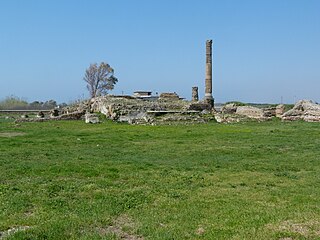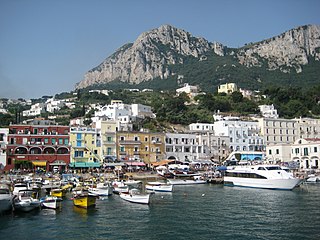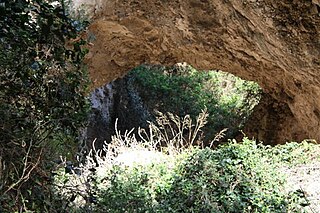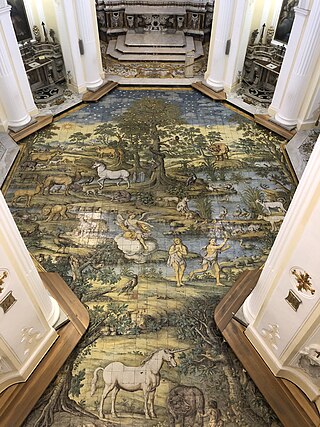

The Arco Naturale is a natural arch on the east coast of the island of Capri. Dating from the Paleolithic age, it is the remains of a collapsed grotto. [1] The arch spans 12 m at a height of 18 m above ground and consists of limestone. [2] [3]


The Arco Naturale is a natural arch on the east coast of the island of Capri. Dating from the Paleolithic age, it is the remains of a collapsed grotto. [1] The arch spans 12 m at a height of 18 m above ground and consists of limestone. [2] [3]

Capri is an island located in the Tyrrhenian Sea off the Sorrento Peninsula, on the south side of the Gulf of Naples in the Campania region of Italy. The largest settlement on the island is the town of Capri. The island has been a resort since the time of the Roman Republic.

Ponza is the largest island of the Italian Pontine Islands archipelago, located 33 km (21 mi) south of Cape Circeo in the Tyrrhenian Sea. It is also the name of the commune of the island, a part of the province of Latina in the Lazio region.

Liternum was an ancient town of Campania, southern central Italy, near "Patria lake", on the low sandy coast between Cumae and the mouth of the Volturnus. It was probably once dependent on Cumae. In 194 BC it became a Roman colony. Although Livy records that the town was unsuccessful, excavation reveals a Roman town existed there until the 4th century AD.

The Sorrento Peninsula or Sorrentine Peninsula is a peninsula located in southern Italy which separates the Gulf of Naples to the north from the Gulf of Salerno to the south.

The Gulf of Naples, also called the Bay of Naples, is a roughly 15-kilometer-wide (9.3 mi) gulf located along the south-western coast of Italy. It opens to the west into the Mediterranean Sea. It is bordered on the north by the cities of Naples and Pozzuoli, on the east by Mount Vesuvius, and on the south by the Sorrento Peninsula and the main town of the peninsula, Sorrento. The Peninsula separates the Gulf of Naples from the Gulf of Salerno, which includes the Amalfi Coast.

The Bourbon Hospice for the Poor, also called il Reclusorio, is a former public hospital/almshouse in Naples, southern Italy. It was designed by the architect Ferdinando Fuga, and construction began in 1751. It is five storeys tall and approximately 354 m (1,161 ft) long. It was popularly known as "Palazzo Fuga". King Charles III of the House of Bourbon meant the facility to house the destitute and ill, as well as to provide a self-sufficient community where the poor could live, learn trades, and work. The massive Hospice at one time housed over 5000 persons, men and women, in separate wings The building is the centre of Naples, which is included in UNESCO World Heritage List.

Capri is a municipality in the Metropolitan City of Naples situated on the island of Capri in Italy. It comprises the centre and east of the island, while the west belongs to Anacapri.

The Sirenusas, also known as the Gallos, are an archipelago of little islands off the Amalfi Coast of Italy between Isle of Capri and 6 km (4 mi) southwest of Province of Salerno's Positano, to which it is administratively attached. They are part of the Campanian Archipelago. The name, Sirenuse, is a reference to the mythological sirens said to have lived there.

Amalfi Cathedral is a medieval Roman Catholic cathedral in the Piazza del Duomo, Amalfi, Italy. It is dedicated to the Apostle Saint Andrew whose relics are kept here. Formerly the archiepiscopal seat of the Diocese of Amalfi, it has been since 1986 that of the Diocese of Amalfi-Cava de' Tirreni.

The Chiesa di San Giovanni del Toro is a church in Ravello, southern Italy.

Marina Grande is the main port of the island of Capri in Italy, to the north of the main town of Capri and at the foot of Mount Solaro.

Marina Piccola is located on the southern side of the island of Capri. It is near the Faraglioni sea stacks to the southeast. The Via Krupp is a historic switchback paved footpath which connect the Charterhouse of San Giacomo and the Gardens of Augustus area with Marina Piccola. The Marina Piccola, used by Augustus and Tiberius, preceded the Marina Grande.

Piazza Umberto I is the most famous square of the island of Capri, Italy. The square is located in the historic center of Capri, in the eponymous town Capri, on the eastern end of the island, and since Roman times, it has been considered the center of the town and the meeting point of the island by both residents and others.

The Grotta di Matromania is a large, natural cave on the east coast of the island of Capri, Italy. It is located near the Arco Naturale. The cave is approximately 27 m long, 18 m wide, and 18 m high. It is connected with Mithras.

Santo Stefano is a Catholic church and former cathedral on the island of Capri, Italy. Dedicated to Saint Stephen, it is the principal house of worship in the town of Capri. The religious complex was built around the Piazza Umberto I square in the seventeenth century. The archbishop's palace is now used as the town hall ("Municipio"). Santo Stefano and Chiesa di San Costanzo are the island's two oldest churches.

Villa Certosella is a hotel in Capri, Italy. Set along the Via Tragara, it was the home of Camille du Locle when he lived in Capri. The villa was enlarged by the illustrator Jan Styka in Italian Renaissance style. Later, Edwin Cerio requisitioned the house so that it is now part of the Ignazio Cerio estate. Cerio removed the Renaissance elements, returning the house to the casa mediterranea style. The master builder, Luigi Desiderio, worked on the property.

San Michele Arcangelo is a Roman catholic church located in Anacapri, Capri, Italy. Located on Piazza San Nicola and built in 1719, it is octagonal in shape and of Baroque style. The church received a "monument" designation due to its notable majolica floor mosaic.
Santa Maria del Soccorso is a church located within the archaeological site of Villa Jovis, on the island of Capri, Italy. It is situated on the summit of the Lo Capo hill at the eastern extremity of the island. The chapel-like church, was constructed ca. 1610. Its fittings include a bronze statue of the Madonna, a 1979 gift of the Caprese painter Guido Odierna (1913-1991). In the late 19th century, hermit lived at the church, keeping a visitor's book and selling wine.
Chiesa di Sant'Andrea is a church in the island of Capri, Italy, near the Marina Piccola in the south. It was built in 1900 for the local fishermen. The site which the church lies on formerly contained a watch tower which was used as a lookout post for invading Saracen pirates. The church was designed by the painter Riccardo Fainardi, and funded by German banker Hugo Andreae and his wife, Emma.

Santa Maria a Cetrella is a Franciscan chapel and hermitage in Anacapri, Capri, Italy. Referred to as "Capri's most otherworldly church", it contains a Madonna statue which is venerated by pilgrims, including Rainer Maria Rilke. Built in the Middle Ages, its features include stucco siding, with a low-vaulted ceiling.
![]() Media related to Arco Naturale (Capri) at Wikimedia Commons
Media related to Arco Naturale (Capri) at Wikimedia Commons